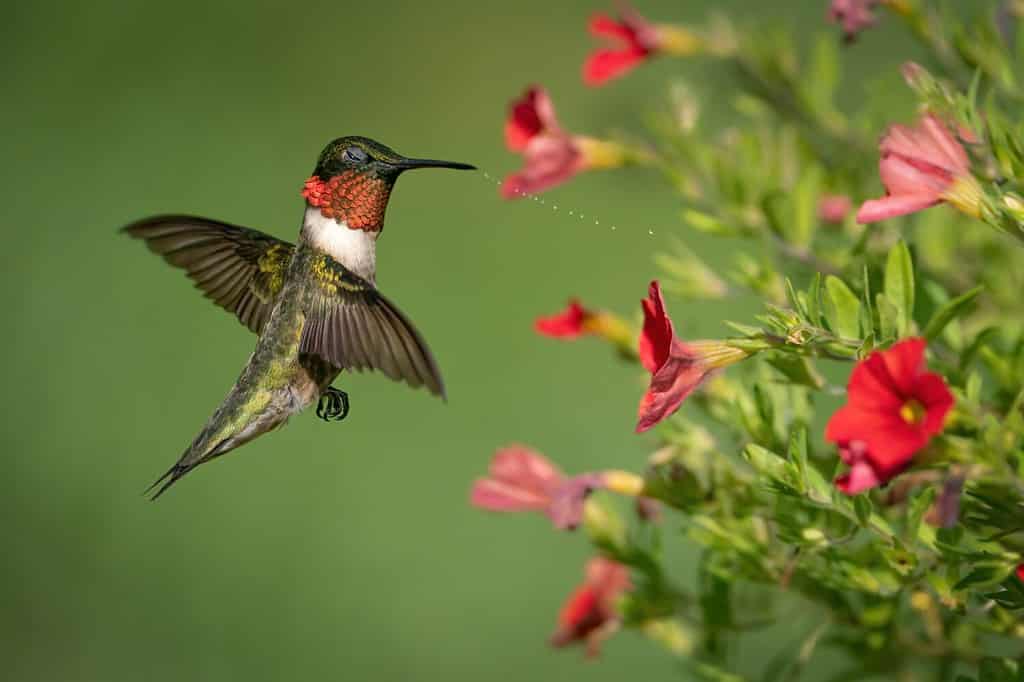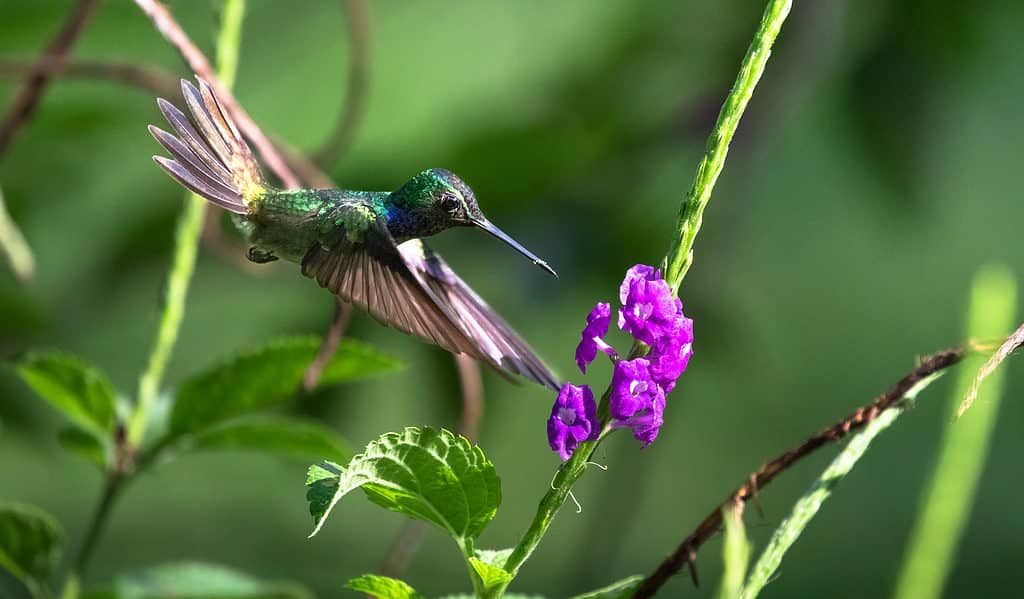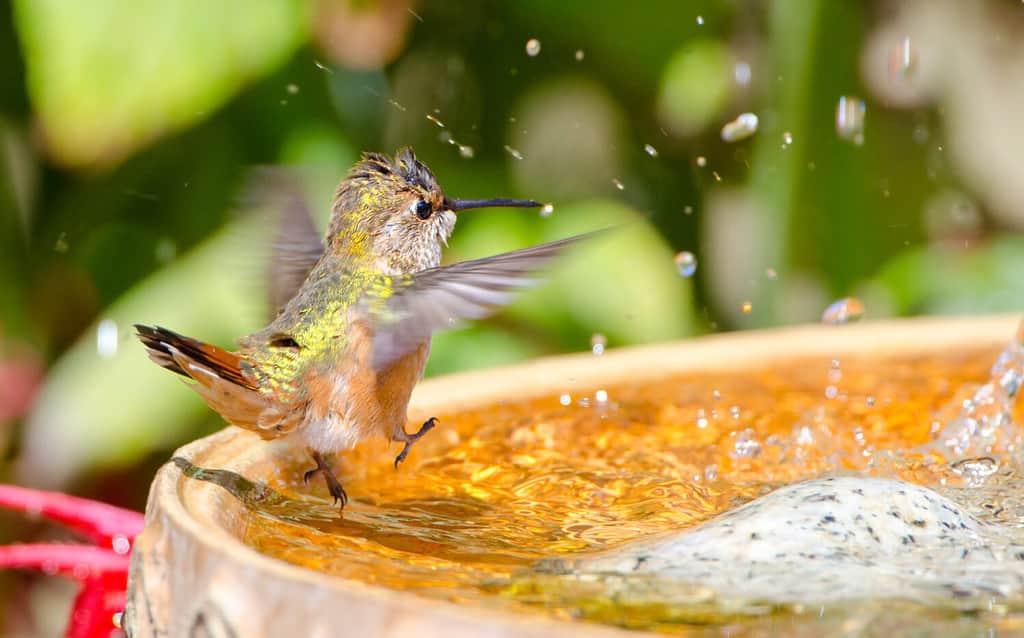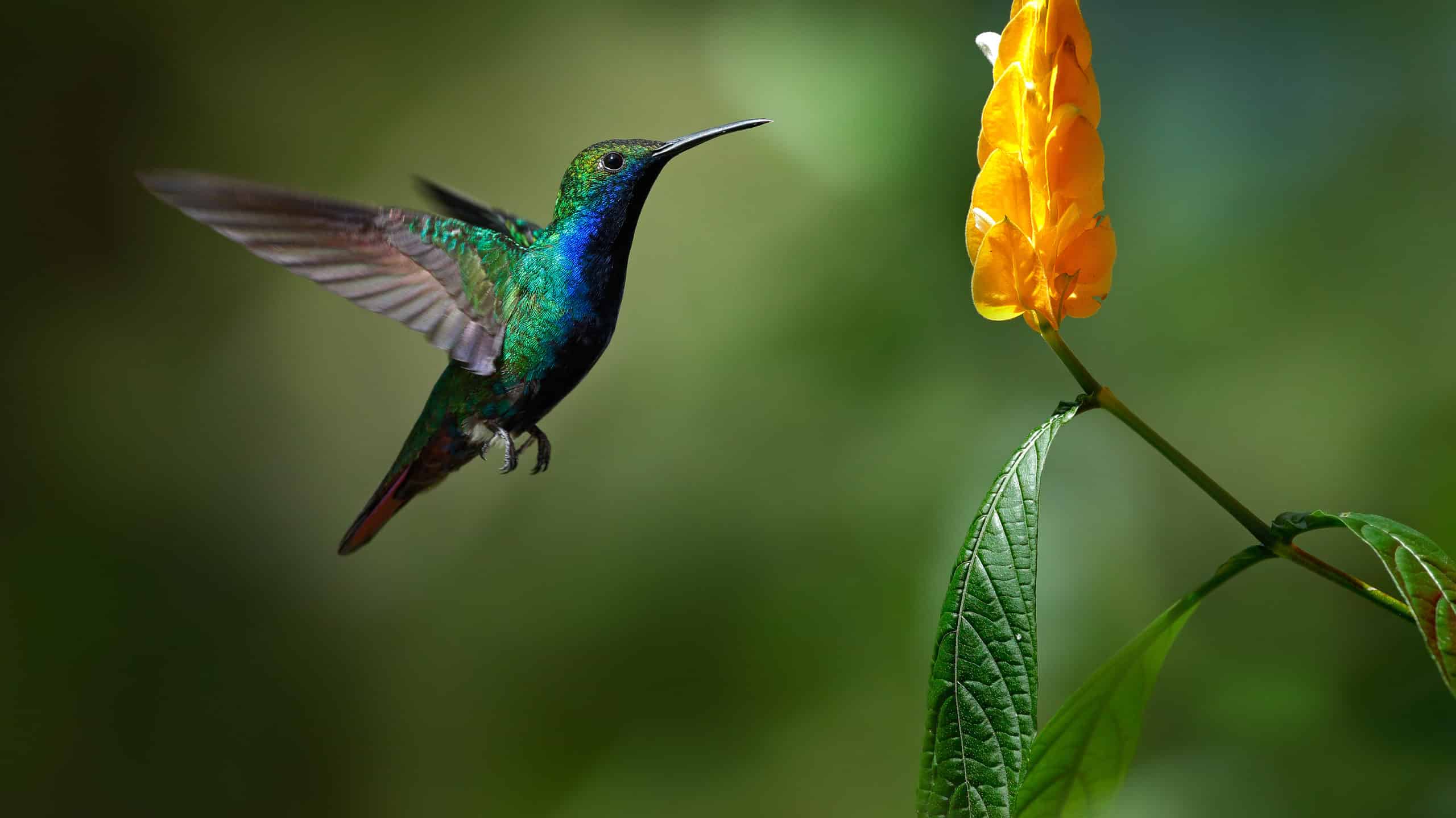Of the four types of hummingbirds that fly in Kentucky, only one is native. The other three are migratory, seasonal birds. Because of the rarity of these birds, ornithologists love hummingbird season — and mourn when the birds inevitably fly away.
Hummingbirds have an interesting migration pattern. Of the 300+ species native to America, only about 15 of them migrate. It’s even more impressive that the only hummingbird species native to Kentucky is one of them!
Discover the four species of hummingbirds you may see in Kentucky, their migration patterns, and more Kentucky-specific information about hummingbird populations.
The Hummingbird Species of Kentucky

Ruby-throated hummingbirds are Kentucky’s most popular species.
©Cavan-Images/Shutterstock.com
The most common hummingbird in Kentucky is the ruby-throated hummingbird (Archilochus Colubris). Nine times out of ten, if you spot a hummingbird in Kentucky, it’s going to be a ruby-throated hummingbird. Why?
Well, the ruby-throated hummingbird remains the most common species in eastern North America. Its population numbers top 35 million and continue to grow. Because they’re the most popular in North America — and because most hummingbirds choose to live in more tropical climates than Kentucky has — it makes sense that this is the most-seen species in the Bluegrass State.
As far as the other hummingbirds seen in Kentucky, ornithologists have sighted the rufous Hummingbird, Anna’s Hummingbird, the Mexican violetear, and the black-chinned hummingbird. While the Anna’s hummingbird, the Mexican violetear, and the black-chinned hummingbird have had only a handful of sightings in the state over the last 100 years, the rufous has seen several pockets of birds make their way to the Kentucky meadows and trees.
Small but Mighty
Hummingbirds are the smallest bird in their genus. As such, they need to conserve their energy and keep themselves in warmer climates. Weathering the winter is not part of a hummingbird’s constitution; in fact, they choose to fly hundreds of miles without stopping rather than stay in a cold region for several months.
Over the many species of hummingbirds, they come in a variety of colors and markings. Some have striking colors like pinks, purples, and reds, while others have a dulled appearance with gray or brown feathers. Males and females have slightly different colorings; the male will have a vibrant gorget (or throat coloring) while females almost always have a white throat.
Wherever hummingbirds fly, their unique beak and function in the ecosystem remain much needed. A hummingbird’s primary role in the food web is a pollinator — as they take flower nectar from one patch, pollen sticks to their beaks. When they feed on the subsequent flower, the pollen is dropped off in the new bloom for pollination. Like bears germinate seeds in the forest with their scat, hummingbirds pollinate the ecosystems in which they live by eating their daily meals.
Hummingbird Migration in Kentucky

The Mexican violetear has a complex and not well understood migration pattern in Kentucky.
©iStock.com/Kevin Wells
The only reason hummingbirds migrate from Kentucky to another location is the weather. Hummingbirds have a fast metabolism: it’s rated as the highest metabolism of all vertebrate animals. Unsurprisingly, though, because they need it to support the rapid beating of their wings. These beats, between 12 and 80 a second, enable the hovering and fast flight humans regard hummingbirds so highly with. That fast wingbeat also serves as the namesake for the bird.
Kentucky has a weird winter. Some regions have a generally warm, albeit wet, climate during the winter months while more northern regions receive significant snowfall. The hummingbirds in Kentucky choose to weather these colder months somewhere else, leaving in late fall and returning in the spring. Here’s a look at the general migration schedule of Kentucky’s hummingbird populations.
- Ruby-throated hummingbirds.
- Leave Kentucky: August or early September.
- Return to Kentucky: Early April.
- Rufous hummingbird.
- Leave Kentucky: September.
- Return to Kentucky: Early May.
- Anna’s hummingbird.
- These hummingbirds tend to not migrate.
- Mexican violetear.
- The migration pattern of these birds is not well understood, as it remains complex based on available food sources, breeding times, and temperatures. In Mexico, these hummingbirds are thought to arrive in November and leave in July.
- Black-chinned hummingbird.
- Leave Kentucky: September.
- Return to Kentucky: March.
Each species of hummingbird found in Kentucky has a unique process for traveling, breeding, and keeping itself alive.
Destination: Where Kentucky’s Hummingbirds Migrate
Typical migration destinations of hummingbirds in Kentucky are generally southward in the fall. Ruby-throated hummingbirds and rufous hummingbirds like to spend their winter in Mexico, the Caribbean Islands, or Central America — which can add up to a nearly 2,000-mile flight in some cases. For rufous hummingbirds flying from Alaska, their trip becomes a whopping 3,900-mile journey to finally experience warm, tropical weather. This ranks as, arguably, the longest migratory journey of any bird in the world based on the displacement of body size. At least for the rufous hummingbird, stopovers don’t exist. They make the entire trip in one incredibly long flight. Other hummingbirds, however, will look for sources of food to maintain their energy. Many birds attempt to add 25% to 40% of their body weight before a migration flight simply because of how many calories those wicked-fast wings will burn.
Not all birds migrate as part of a flock. Some ruby-throated hummingbirds live solitary lives and choose to migrate on their own. This makes common challenges like unexpected cold fronts and heavy rain harder to weather.
Non-Migratory Hummingbird Species
Anna’s hummingbird and the Mexican violetear are two species of hummingbirds seen in Kentucky that don’t migrate. Instead, these year-round birds put their bodies through torpor: a deep sleep state entered autonomously to conserve energy. This is especially helpful for hummingbirds when flower nectar dries or freezes in the winter months.
During torpor, hummingbirds slow their body functions to a near-death state. Their heart rate and breathing rate slow to around 100 beats per minute as compared to the daytime rate of 1000+ beats per minute. A hummingbird found in the Andes mountains that was in torpor had a body temperature of 38 degrees Fahrenheit: the lowest recorded level for a bird.
Lastly, kidney functions decline to preserve glucose stores. One of the only things that can rouse a hummingbird from torpor is the hormone corticosterone — which regulates energy, immune reactions, and responses to stress.
Hummingbird-Friendly Habitats in Kentucky

Rufous hummingbirds love to bathe themselves in backyard birdbaths.
©Birdiegal/Shutterstock.com
Creating a hummingbird-friendly garden isn’t too difficult if you have a green thumb. Add just a few lawn ornaments, plant some flowers, and hummingbirds will begin to flock to your custom hotel.
First on your list to create a hummingbird-friendly habitat is a bird bath. Hummingbirds prefer to have fresh water, so filling up the bath daily with clean water ensures they’ll learn where the best water is. The plants that attract hummingbirds more than others are part of the mint family. They include:
- Salvia.
- Bee balm.
- Hyssop.
Most notably, hummingbirds love to feed from plants of the honeysuckle family. The most important factor in choosing flowers to plant is native consideration. Is this flower or plant native to Kentucky? If not, take special care in planting it around other native plants — while hummingbirds like the invasive plant Purple-top Vervain, it’s not native to some regions and could cause ecological issues.
The Kentucky Hummingbird Festival
Outside of citizen science projects and research, Kentucky hosts an annual festival to celebrate the migration patterns of its hummingbirds.
The Hummingbird Fest, held in August in Cadiz, Kentucky, promotes education about the different types of hummingbirds in the area. One of the major activities of the festival is hummingbird banding — the process of “tagging” a hummingbird to track its behavior and migration patterns. Because only five species frequent Kentucky, researchers, and ornithologists remain curious about the patterns that bring hummingbirds to and from the Bluegrass State.
Outside of educational exhibits and lectures, the fest includes a native plant sale, local artisan booths, crafts, and a pollinator photo exhibit.
Tips for Observing Hummingbird Migration
Unless you live near the Woodlands Nature Station in Cadiz or a flower-filled meadow in the country, the best place to observe hummingbirds is in a custom-created garden you make yourself in your backyard. Put feeders out in mid-March to get the scent in the air and signal to birds that your yard has food. As the birds migrate in, they’ll find your oasis and may use it as a stopover point toward their final destination — or frequent it for the rest of the season.
The Human Impact on Hummingbird Migration
Surprisingly, one of the conservation challenges facing hummingbirds in Kentucky is none other than well-intentioned but uneducated Good Samaritan acts by humans.
Because Kentucky’s winters are unpredictable —to say the least — hummingbirds may migrate back to their “home base” in Kentucky before the frost has thawed. When they encounter a cold like that, they’d go into a torpor state (as mentioned above) and can look dead or nearly dead to the untrained eye.
While it’s kind to want to bring the bird inside to warm up, this actually endangers its life significantly. This change in environment messes up the bodily functions of a hummingbird as it then struggles to come out of torpor in an unfamiliar home and climate. Overall, it’s best to leave hummingbirds be — even if they look like they’re freezing.
Helping hummingbird conservation efforts will look different in every state based on the Department of Natural Resources’ initiatives. However, national initiatives exist to ensure every human who wants to contribute to a safer world for hummingbirds has a place to learn.
According to the North American Pollinator Protection Campaign (NAPPC), residents with local hummingbird populations can affix several habitats in their yards to shorten a hummingbird’s journey to food. You can plant nectar plants — or try your hand at the careful use of a feeder. In addition to food, hummingbirds need water. If you’d like to also provide a water source, opt for a fountain, sprinkler, or birdbath with a mister to keep hummingbirds cool and hydrated.
In the wider world, hummingbirds do face some conservation challenges. Loss of habitat, loss of specific pollination plants, predators, and climate change preclude some hummingbird species from thriving. The Hummingbird Conservation Network and the Pollinator Partnership are two types of non-profit conservation groups dedicated to protecting this delicate creature.
The World’s Smallest Living Bird
Hummingbirds are fascinating avian creatures, with beautiful feathers and an important role to plan in the ecosystems they inhabit. From Kentucky, some travel as far as 1,500 miles in a single trip to avoid the cold weather. Others, however, choose to winter in Kentucky’s warmest regions and hope they can handle the cold.
Creating hummingbird-friendly habitats and observing hummingbirds at a distance increases public awareness of these wonderful birds. It also ensures the continuation of the most endangered species.
Up next, learn more about the other animals in Kentucky, or discover what the meaning and significance of a hummingbird spiritual animal is.
Thank you for reading! Have some feedback for us? Contact the AZ Animals editorial team.








